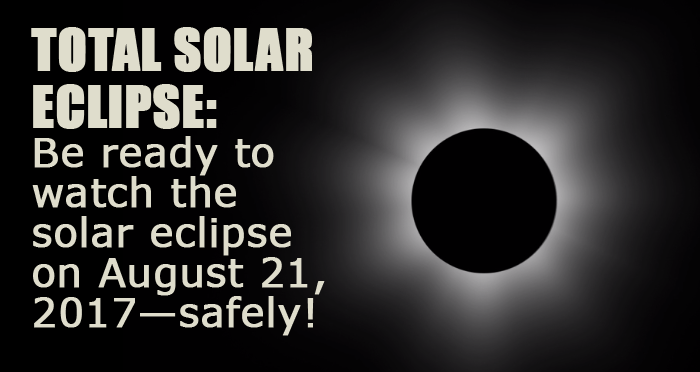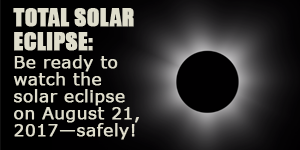Gear Up for the August 2017 Solar Eclipse
Is watching the solar eclipse on your calendar? If you haven't already picked up special glasses for the solar eclipse, make sure you plan ahead to ensure safe viewing!

Total Solar Eclipse Visible in the United States
The solar eclipse that will occur on August 21, 2017 is the first total solar eclipse that will be visible in the U.S. since 1979. In a solar eclipse, the moon passes between the sun and Earth and blocks our view of the sun. The sun is 400 times the size of the moon and 400 times farther away from Earth, so when the moon crosses in front of the sun at just the right point in its elliptical orbit, the smaller moon lines up with the sun and can appear to completely block the sun, leaving only the ring of the corona of the sun's outer atmosphere visible.The path of the moon during a total solar eclipse is referred to as the path of totality. If you are in the path of totality, you can see a total solar eclipse; if you are outside of the path of totality but still in a viewing area, you will see a partial eclipse. The moon's trajectory during the coming eclipse will cross the U.S. from coast to coast, making the August 2017 solar eclipse a rare astronomical viewing opportunity for students in the United States. The last eclipse visible in parts of the U.S. was in February 1979. The last time a solar eclipse was visible from coast to coast in the U.S. was June 1918! The next total eclipse viewable in the U.S. will be in 2024.
People who live in the path of totality during the August 21, 2017 solar eclipse will see the sun obscured by and then completely blocked by the moon over the course of a few (2-3) hours. For people viewing the eclipse in these areas, the sun will appear to "go dark." The amount of time the moon will appear to block the sun during a total solar eclipse is called the "duration of totality" and will vary by location (and varies by eclipse). According to Space.com, the "maximum duration of totality for this eclipse will be 2 minutes and 40 seconds." (The total solar eclipse on July 16, 2186 will be the longest on record and is projected to last 7 minutes, 29 seconds.)
According to NASA, in North America, the path of totality for the August 21, 2017 total solar eclipse stretches from Lincoln Beach, Oregon to Charleston, South Carolina. The Challenger Center site lists the following fourteen states as being in the path of totality: Oregon, Idaho, Wyoming, Montana, Nebraska, Iowa, Kansas, Missouri, Illinois, Kentucky, Tennessee, Georgia, North Carolina, and South Carolina. Those who live outside of the path of totality will only see a partial eclipse of the sun, but the partial eclipse should be viewable throughout the U.S.
Safe Viewing is a Must!
Safe viewing during the solar eclipse is very important to prevent eye damage. Even though the sun may appear to be partially darkened during the eclipse, you should not look directly at the sun without proper solar viewing glasses. It is only safe to look at the sun during the brief time of total eclipse. Special solar glasses are needed for safe viewing of the eclipse. Solar glasses should be ISO 12312-2 compliant.
To view the eclipse indirectly, a solar viewing projector or a pinhole viewer can be used. To learn more about the science behind making and using a pinhole viewer or pinhole camera, see:
- Family Science: Pinholes and Safe Solar Viewing
- Pinhole Viewer: Trying Again for the Transit
- Point, Click, Shoot! Photography with a Pinhole Camera
- Digital Pinhole Camera
(On the NASA site, you can find directions for making a pinhole viewer in the shape of the United States.)
Plan Ahead
How far are you from the path of totality? How much of a solar eclipse will you see? When will the eclipse reach you? The eclipse will be passing across the U.S. from the West Coast to the East Coast, with viewing times starting in the morning and the first totality happening in Oregon shortly after 10 AM PST. To find out when you will be able to view the solar eclipse in your area, use NASA's interactive map at https://eclipse2017.nasa.gov/sites/default/files/interactive_map/index.html.
Click on any location on the map to see a popup box that outlines key viewing time information (as shown in the example below). See also: Eclipse: Who? What? Where? When? and How?.

Learn More
To learn more about the August 2017 solar eclipse, visit NASA's Eclipse 2017 site where you can find important safety information, in-depth coverage of eclipse science, STEM information for schools, home science activities, citizen science information, and more. For additional safety information, see the following posts on the Challenger Center site: Safety 101 and Safety 101 Part 2.
STEM Careers in Astronomy
The total solar eclipse is a major astronomical event and draws attention from people of all ages. Seeing the sun go dark is an unforgettable experience for someone in the path of the moon during an eclipse. But for astronomers, fascinating and amazing sky events are subjects of discussion and study every day! Students excited about the total solar eclipse and interested in learning more can explore related STEM career information:
Create an Assignment
If you are a Google Classroom user, consider assigning this page to your students with directions to watch a video, use the interactive NASA map to determine local viewing times, learn more about pinhole viewers, read science news articles related to the total solar eclipse, or research important terms related to the eclipse, including: Baily's beads, corona, diamond ring (stage of the eclipse), total eclipse (compared to other types), the umbra, and the sun's chromosphere.
Learn more about using Google Classroom and Science Buddies is this blog post: Back to School with Science Buddies' Google Classroom Integration.
Categories:
You Might Also Enjoy These Related Posts:
- Plastics and Earth Day - Science Projects
- Arduino Science Projects and Physical Computing
- 10+ Robotics Projects with the BlueBot Kit
- 5 STEM Activities with Marshmallow Peeps
- March Madness Basketball Science Projects: Sports Science Experiments
- Women in STEM! More than 60 Scientists and Engineers for Women's History Month
- Explore Artificial Intelligence and Machine Learning with Student AI Projects
- 10 Reasons to Do the Rubber Band Car Engineering Challenge










